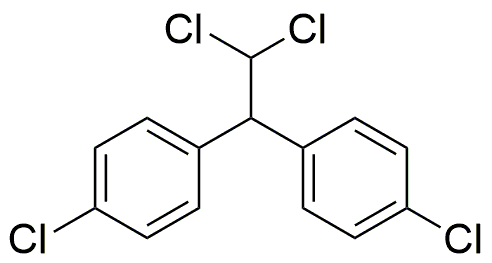2,2-Bis(4-chlorophenyl)-1,1-dichloroethane is widely utilized in research focused on:
- Pesticide Development: This compound serves as a key intermediate in the synthesis of various pesticides, providing effective solutions for crop protection in agriculture.
- Pharmaceutical Research: It is used in the development of certain pharmaceuticals, particularly in creating compounds that target specific biological pathways, enhancing drug efficacy.
- Polymer Manufacturing: The chemical is employed in producing specialty polymers, which are essential in various applications, including coatings and adhesives, due to their durability and resistance to chemicals.
- Environmental Studies: Researchers utilize it to study the degradation pathways of chlorinated compounds, helping to understand their environmental impact and develop remediation strategies.
- Analytical Chemistry: It serves as a standard reference material in analytical labs for calibrating instruments and validating methods used to detect similar compounds in environmental samples.
General Information
Properties
Safety and Regulations
Applications
2,2-Bis(4-chlorophenyl)-1,1-dichloroethane is widely utilized in research focused on:
- Pesticide Development: This compound serves as a key intermediate in the synthesis of various pesticides, providing effective solutions for crop protection in agriculture.
- Pharmaceutical Research: It is used in the development of certain pharmaceuticals, particularly in creating compounds that target specific biological pathways, enhancing drug efficacy.
- Polymer Manufacturing: The chemical is employed in producing specialty polymers, which are essential in various applications, including coatings and adhesives, due to their durability and resistance to chemicals.
- Environmental Studies: Researchers utilize it to study the degradation pathways of chlorinated compounds, helping to understand their environmental impact and develop remediation strategies.
- Analytical Chemistry: It serves as a standard reference material in analytical labs for calibrating instruments and validating methods used to detect similar compounds in environmental samples.
Documents
Safety Data Sheets (SDS)
The SDS provides comprehensive safety information on handling, storage, and disposal of the product.
Product Specification (PS)
The PS provides a comprehensive breakdown of the product’s properties, including chemical composition, physical state, purity, and storage requirements. It also details acceptable quality ranges and the product's intended applications.
Certificates of Analysis (COA)
Search for Certificates of Analysis (COA) by entering the products Lot Number. Lot and Batch Numbers can be found on a product’s label following the words ‘Lot’ or ‘Batch’.
*Catalog Number
*Lot Number
Certificates Of Origin (COO)
This COO confirms the country where the product was manufactured, and also details the materials and components used in it and whether it is derived from natural, synthetic, or other specific sources. This certificate may be required for customs, trade, and regulatory compliance.
*Catalog Number
*Lot Number
Safety Data Sheets (SDS)
The SDS provides comprehensive safety information on handling, storage, and disposal of the product.
DownloadProduct Specification (PS)
The PS provides a comprehensive breakdown of the product’s properties, including chemical composition, physical state, purity, and storage requirements. It also details acceptable quality ranges and the product's intended applications.
DownloadCertificates of Analysis (COA)
Search for Certificates of Analysis (COA) by entering the products Lot Number. Lot and Batch Numbers can be found on a product’s label following the words ‘Lot’ or ‘Batch’.
*Catalog Number
*Lot Number
Certificates Of Origin (COO)
This COO confirms the country where the product was manufactured, and also details the materials and components used in it and whether it is derived from natural, synthetic, or other specific sources. This certificate may be required for customs, trade, and regulatory compliance.


